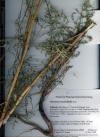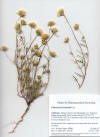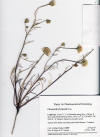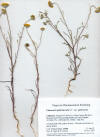
Chaenactis artemisiifolia
Peninsular Ranges, CA
Spjut & Marin 15319,
May 2003 |

Chaenactis carphoclinia
California—Inyo Co.: SW of Lone Pine, Cottonwood Road
4 May 2008
|

Chaenactis douglasii
Kern Co., CA. Piute Mt
30 Apr 2005 |
 
Chaenactis fremontii
Forming complete cover on rocky ground, not yet in flower, Chuckwalla Mts., CA
Spjut 15848, Mar 2005 |

Chaenactis fremontii
NW of Sheephole Mts., CA
Mar 2005 |

Chaenactis fremontii
Joshua Tree Natl. Park, CA
Mar 2005 |

Chaenactis fremontii
Kingston Range, CA
Spjut 1561, May 2003 |

Chaenactis fremontii
W Mojave Desert, CA
Spjut 15207, Apr 2003 |

Chaenactis fremontii. Anza Borego
St. Park. Photo by Sally Larsen
Mar 2005. Note: This species is recognized by noticeably larger
flower around the perimeter of the flower head. |
 
Chaenactis fremontii
with Malacothrix glabrata
~4.5 miles N of Palm Springs, CA
April 1973 |

Chaenactis glabriuscula
Kern River Canyon, CA
Spjut 15205, Apr 2003 |

Chaenactis glabriuscula
Kern River Canyon, CA
Apr 2005 |

Chaenactis stevioides
California—San Bernardino Co.,
between 29 Palms and
Blythe, Spjut 15754,
Mar 2004
|

Chaenactis suffrutescens
California—Klamath
Region. Siskiyou Co.: Scott Valley, South Kidder Creek west of Greenview
on north side of Hwy 3, between Ft. Jones and Etna; 41º32'27.5",
122º54.26.4", 860 m. Open wide gravel creek bed. Perennial with white
flowers; common along gravel bar. Sample of entire plant. Richard Spjut
& Paul Burchstead 16339, 12 Jun 2008
|
 
Chaenactis xantiana
California—Los Angeles Co.,
Western Mohave Desert Lake Elizabeth Rd, east of lake, abundant. , 24 Apr
2014. Pappus scales 4
long and 4 short in 2 series. |
|
Constabel C.
P. and G. H. Towers. 1989. The complex nature of the mechanism of
toxicity of antibiotic dithiacyclohexadiene polyines (thiarubrines) from
the Asteraceae. Planta Med. 55(1): 35–37.
“Thiarubrine A, a dithiacyclohexadiene polyine from the roots of
Chaenactis douglasii, and a related dithiacyclohexadiene from
Rudbeckia hirta exhibit strong light-independent antibacterial and
antifungal activity. This activity is enhanced by exposure to visible
light. Visible light also converts the compounds to the corresponding
thiophenes. These are antibiotic only when irradiated with UV-A.
Dithiacyclohexadienes are the first polyines to exhibit such complex
mechanisms of toxicity towards microorganisms.” |